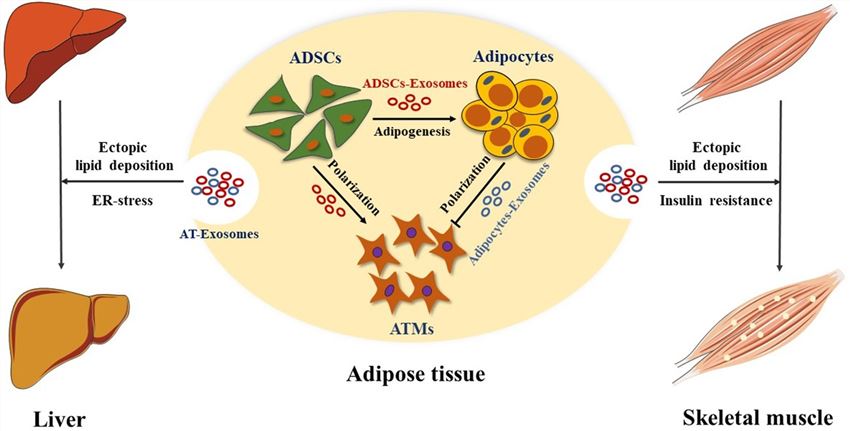Muscle-Liver Exosome Communication Research Introduction
Relationship between Muscle and Liver
The liver is the second largest organ in the human body and the main organ of metabolism, and its functional integrity is critical for the supply and interorgan transport of macronutrients (proteins, fats, and carbohydrates) and their metabolism. Muscle is the largest protein pool in the human body, and the loss of skeletal muscle is the main cause of malnutrition. Therefore, muscle mass is a relatively more reliable and effective indicator for estimating nutritional status. Skeletal muscle loss is prevalent in patients with cirrhosis and liver cancer. However, the mechanism by which skeletal muscle loss participates in promoting the progression of liver disease has not been elucidated clearly.
Exosomes are small membrane-bound vesicles released by many different types of cells in the body. They carry a variety of proteins, lipids, and genetic material that can be carried through the bloodstream to other parts of the body, where they affect the behavior and function of target tissues. Creative Biolabs has been focusing on the research progress of exosomes in the mechanism of disease progression and can provide research services on exosomes derived from muscle tissue and liver tissue to promote the discovery of the regulatory mechanism between skeletal muscle loss and liver disease.
Exosome Research on Muscle-Liver Communication
It is well known that regular physical activity improves human health. Skeletal muscle is a type of muscle that attaches to bones and helps move the body. Regular physical activity increases muscle mass and liver metabolism. Some researchers have proposed that patients with liver disease should actively maintain physical exercise to improve skeletal muscle mass in order to improve the prognosis of patients. In the previous study, researchers hypothesized that exosomes derived from muscle tissue could regulate liver function based on the communication function of exosomes between tissues. They extracted muscle tissue, liver tissue, adipose tissue, and plasma-derived exosomes from mice subjected to high-intensity intermittent exercise and sedentary mice. Exosomal miRNA sequencing and comparative analysis results showed that high-intensity intermittent exercise altered the expression profile of muscle tissue-derived exosomal miRNAs. Through further in vivo functional experiments, they found that muscle tissue would release exosomes containing specific miRNAs to down-regulate the expression of FoxO1 (transcription factor of the insulin gene) in liver cells and increase the sensitivity of the liver to insulin, thereby increasing the glucose tolerance in the liver of sedentary mice and metabolism of glucose and lipids.
 Fig.1 Adipose tissue-derived exosomes modulate ATM polarization and adipogenesis in adipose tissue, liver and skeletal muscle.1,2
Fig.1 Adipose tissue-derived exosomes modulate ATM polarization and adipogenesis in adipose tissue, liver and skeletal muscle.1,2
Muscle-Liver Exosome Communication Research at Creative Biolabs
Studying the mechanism of muscle-liver exosome communication is crucial for preventing and treating liver diseases and improving the prognosis of patients with liver diseases. If you have been looking for a suitable technology platform to study the exosome communication mechanism between muscle and liver, please contact us and leave your specific ideas or needs on the website. Creative Biolabs is a supplier focused on providing exosome technical services. Our professional sales staff and technical team can provide you with the most rigorous experimental plan and the best one-stop technical service for tissue exosomes. From tissue exosome extraction, identification and profiling, to exosome NGS, exosome proteomics, exosome lipidomics and metabolomics, to the newly added tissue exosome related services, you can find it all on our technology platform.
References
-
Zhao, R.; et al. Composition, isolation, identification and function of adipose tissue-derived exosomes. Adipocyte. 2021, 10(1):587-604.
-
under Open Access license CC BY 4.0, without modification.
For Research Use Only. Cannot be used by patients.
Related Services:

 Fig.1 Adipose tissue-derived exosomes modulate ATM polarization and adipogenesis in adipose tissue, liver and skeletal muscle.1,2
Fig.1 Adipose tissue-derived exosomes modulate ATM polarization and adipogenesis in adipose tissue, liver and skeletal muscle.1,2









